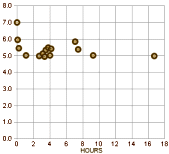 As the pictures keep coming in from Haiti, the amount of devastation becomes increasingly horrific. Looking on the USGS earthquake site, there were a number of major aftershocks, Richter 5.0 or greater. Those surely had something to do with the collapse of so many buildings. Another complicating factor was that the earthquake hit at 4:53 PM yesterday. Sunset in Haiti yesterday was at 5:32 PM, only half an hour after it all started. So most of those aftershocks [on the right] happened after nightfall when there was no sunlight and the electricity was compromised by the earthquake. What a nightmare [literally]!
As the pictures keep coming in from Haiti, the amount of devastation becomes increasingly horrific. Looking on the USGS earthquake site, there were a number of major aftershocks, Richter 5.0 or greater. Those surely had something to do with the collapse of so many buildings. Another complicating factor was that the earthquake hit at 4:53 PM yesterday. Sunset in Haiti yesterday was at 5:32 PM, only half an hour after it all started. So most of those aftershocks [on the right] happened after nightfall when there was no sunlight and the electricity was compromised by the earthquake. What a nightmare [literally]!There’s a brief New York Times video [that I can’t embed] that’s really worth looking at. It’s entitled Haiti’s Legacy of Environmental Disaster. It’s about something that we saw in the Masai Area of Kenya – massive deforestation as people cut down trees to make charcoal to sell. The impact is massive erosion that leads to flooding – something that has plagued Haiti in recent years. In rural areas, there is no electricity, so charcoal is the only way to heat, cook, have light after sundown. The Haitians can tell you how it is destroying the environment [as can the Kenyans], but they feel trapped in a cycle they can’t escape.
Haiti is 95% Catholic and birth control usage is low according to the World Health Organization. The general fertility rate is 4.8 children per woman for women aged 15–49 years old. Among sexually active women, 13% use a modern method of contraception and 4% relied on traditional methods. Among sexually active men, 17% used a modern method and 16% relied on traditional methods. So Haiti is very much like the underdeveloped countries in Africa, suffering from problems of over population, but resistant to the available methods of population control on religious grounds.
Sorry, the comment form is closed at this time.